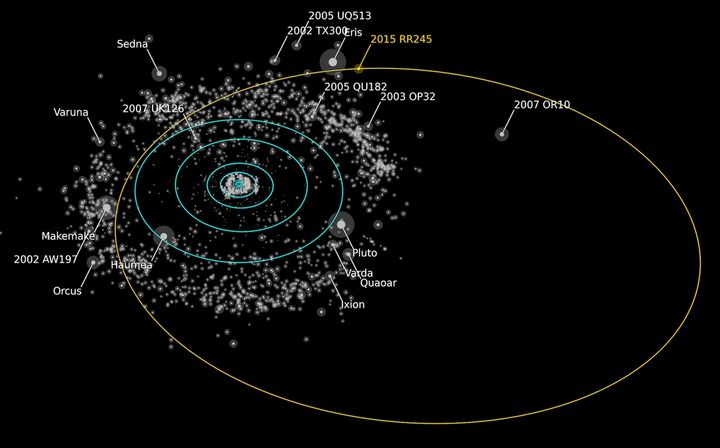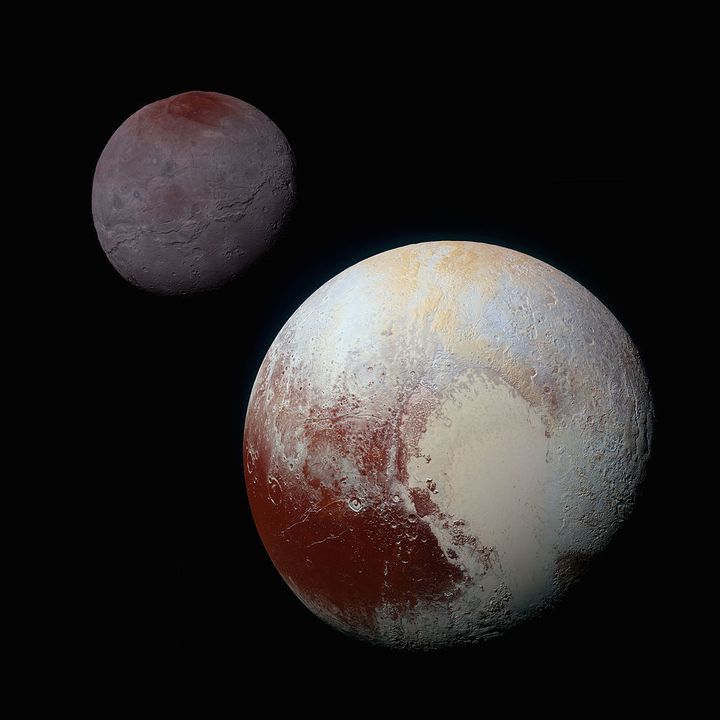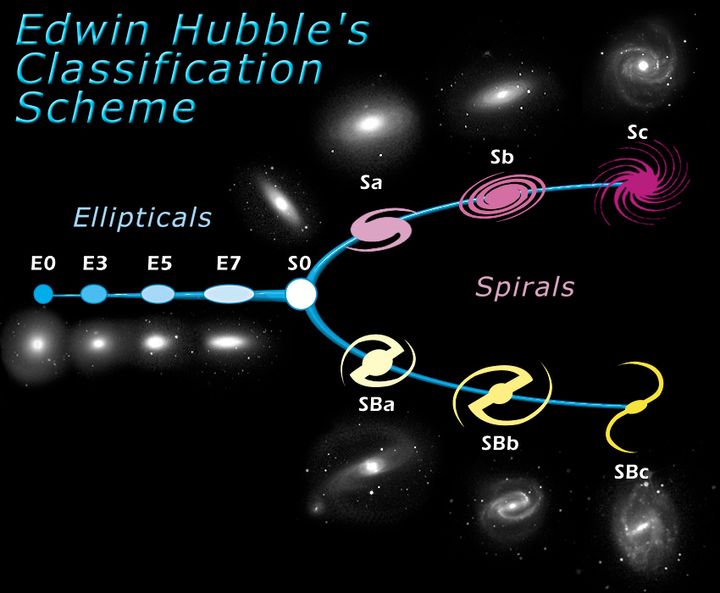The original news release and mass media outlets recently misled you to believe that a new “dwarf planet” was discovered far beyond the orbit of Pluto. This is why there is no new “dwarf planet”.

I am one of the happiest people on Earth when new discoveries are made within the cosmic neighborhood. Ever since I wanted to be an astronomer (at twelve, as far as I can remember) I wanted to know everything about the Solar System. Happy lane-changes in the freeway of life led me into gravitational lensing of distant galaxies, public outreach and informal education of astronomy. I have visited over 100 classrooms in Southern California this last academic year and the confusion that Pluto’s reclassification still causes amongst teachers, and therefore is passed down to students, bewilders me.
It’s all a naming game and here’s why it should matter to you.
PLUTO & “DWARF PLANETS”
The outrage was so big, that what would otherwise just be another international meeting of astronomers in Paris in the year 2006, suddenly became a news sensation: Pluto was no longer a “planet”.
Due to the dawn of more refined and advanced telescopes and detectors, the list of objects beyond the orbit of Neptune that were massive, near-spherical in shape, and orbited the Sun, grew enormously. The race was on, most discoverers were eager to have their own object-beyond-the-orbit-of-Neptune classified as a new “planet”. Who wouldn’t like to be added to the select pantheon of planet-discoverers together with Herschel (Uranus), Le Verrier/Galle (Neptune) and Tombaugh (Pluto)?
The Solar System was becoming a mess, a non-ending directory of so-called planets. Some were smaller than Pluto, others were egg-shaped, most were moonless, a majority had elliptical orbits instead of near-circular. Are they all “planets”? Just how egg-shaped could it be before being called something else? Would an extremely elongated orbit taking it to the outer Solar System classify the object as something different?
Fortunately astronomers have a worldwide governing body, the International Astronomical Union (IAU). Consisting of over 12,000 astronomers from 74 countries, it is the sole recognized authority for assigning designations of celestial objects.
Sorry Paris, back to you. A heated vote in 2006 called for a new classification, “dwarf planets”: a body orbiting the Sun, nearly round in shape due to self-gravity forces, which is not a satellite and has not cleared its neighborhood around its orbit (several asteroids are found in its path around the Sun).

PICKY PICKY PICKY
Correct classification and a governing body to overview it was of utmost importance in the turn of the nineteenth century. Photography was revolutionizing astronomy. Careful catalogues were now being created of the stars, but several similar endeavors were each naming the same star in a different way (the BD, HD, CD, AC catalogues, among many others). The problem was that they were not using the same reference system, did not account for the proper motion of stars, and did not have a preset date for calculations. The conundrum became paramount when the first satellites went into orbit and stars’ positions were required to maintain them in precise orbits.
In the early twentieth century, astronomers were also very busy classifying galaxies. Were they spiral, elliptical, lenticular or irregular? Did they present a ring-like structure, a bar, or none? Were the arms of a spiral galaxy tightly wound around the core, widely open, or somewhere in between? Several astronomers made catalogues that were later reworked by colleagues. The whole effort was made with the light telescopes and photography worked on in the era: the visual spectrum. Later, when astronomers started seeing galaxies through infrared light or radio waves, they presented wildly different shapes evidencing different physical phenomena. The morphological classification of galaxies is still an area of active research and debate. Similar classification headaches have appeared in active galactic nuclei (AGNs), gamma-ray bursts, supernovae, young stars, you name it. If there is a particular area where strides have been made, it is classification of objects in the Solar System.
It all seems harmless until you bring in politics. Uranus was almost named George’s Star by Herschel in honor of his patron, King George III of Great Britain and Ireland. The Cold War advanced space exploration and the names of surface features on planets, moons and asteroids would have been up for grabs. Thanks to the IAU we don’t have Stalin Crater, Asteroid Cortés or Hitler Mount, ok, I exaggerated a bit, but we alternatively have Asteroid BenFranklin (5102), Crater Diego Rivera (Mercury), Asteroid Jimihendrix (4738), although some choices might be dubious.
Money is also a factor. The Sloan Digital Sky Survey (SDSS), one of the biggest telescope sweeps of the night sky, assigns names like SDSS-something to thousands of newly discovered objects. The project is named after Alfred P. Sloan Jr., whose posthumous foundation heavily (and gratefully) invested in the project. Presently new catalogued objects are named after the instrument used in the discovery, but in the advent of technologies of information and standard coordinates, it is easy to cross-reference them.
Admittedly the IAU is leaner on the naming of stars and galaxies (as there are sextillions of them) and has a firmer hold on the Solar System.

TERMS, TERMS, TERMS
So what are these large pieces of rock being discovered in increasing numbers in the outer Solar System? They are Trans-Neptunian objects (TNOs), “minor planets” which are an astronomical object in direct orbit around the Sun that is neither a planet nor exclusively classified as a comet, whose orbit at one point reaches farther than Neptune’s. You have probably heard some of the most prominent names: Sedna, Quaoar, Orcus.
Streets are built by developers or cities and they propose names, but it all goes through a council that approves them, making sure the designation is unique, intelligible and distinguishable. A similar process happens with newly discovered objects in the Solar System. They are waiting in line to be clasified as “dwarf planets” and to be aptly named by the IAU, joining an exclusive list currently made-up by Ceres, Pluto, Haumea, Makemake and Eris.
Newly discovered object RR245, recently on the news and wrongly labeled “dwarf planet” by the discovery team at the Canada-France-Hawaii-Telescope (CFHT), is in fact a trans-Neptunian object. It’s at the back of a long line waiting for the IAU.

ROGUES & EDUCATION
I’m the first to cheer the rogues: in the Justice League, the X-Men and in the Star Wars Galactic Empire. Some even exist in the scientific community of astronomers. Thinking out of the box and not being constrained by definitions and preconceptions has proven to be of utmost importance for the advancement of humanity. Nevertheless, classifications, conventions and rules are setup in science for a reason, and in particular I am concerned about education.
Pluto’s demise as a planet is still creating a lot of confusion in schools. Ten years after the decision in Paris, teachers are still having a hard time explaining and understanding what exactly makes a celestial object a “dwarf planet”. Is it the size, or the mass, or its distance to the Sun? Was it all an incommunicable schism among astronomers?
Textbooks take too long to get written, revised and published, and with certainty the information will be outdated in fields of science where leaps are made yearly, such as genomics, astronomy, biology and medicine. Fortunately for scientists the mass media has been a very good ally to communicate new important discoveries. Educators get most of their fascinating discoveries news through these mass media outlets (TV, newspapers, magazines, specialized websites). But when the source is distorted, it trickles down and creates additional confusion, which in my experience is then delivered to the students. Special emphasis is also given in elementary and middle school syllabi to the solar system “family”, making it a priority to get the facts right.
The discovery of RR245 is astounding and shows just how far science and technology has taken humankind. It is bound to be followed by hundreds of new trans-Neptunian discoveries. That’s why we should be mindful of conventions designed to convey science as clearly as possible.
